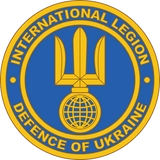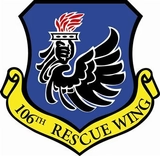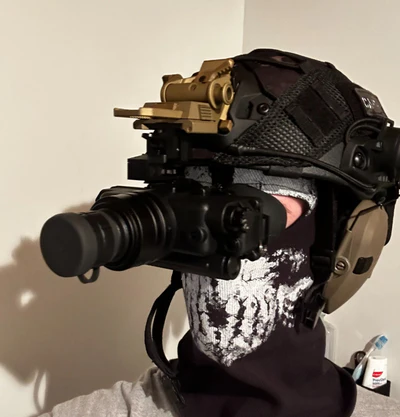Est. 2014 | USA Small Business
Night Vision Goggles | L3Harris, Elbit & Photonis
Night Vision Goggles | L3Harris, Elbit & Photonis
Introduction to Night Vision Technology
History of Night Vision
The concept of night vision technology dates back to World War II and the Cold War era. Here's a brief history:
World War II
The first practical night vision devices were introduced by the German army as early as 1939. The system was primitive, involving an infrared spotlight coupled with an infrared-sensitive telescope, but it gave German soldiers an advantage in the dark.
1940s - 1950s: Generation 0
The US Army developed the first active infrared night vision system, the "Sniperscope" or "Snooperscope," during World War II, which was used in the Korean War. These devices, known as "Generation 0," used large, active infrared lights to illuminate targets.
1960s: Generation 1
By the 1960s, passive night vision systems, which rely on ambient light instead of an infrared light source, became a reality. This "Generation 1" technology was used extensively by both sides during the Vietnam War.
1970s: Generation 2
"Generation 2" night vision devices, which offered improved resolution and performance over their predecessors, were developed in the 1970s. This generation used a microchannel plate (MCP) for amplification and required less ambient light to function effectively.
1980s - 1990s: Generation 3
"Generation 3" devices arrived in the 1980s and are still in use today. They have a significantly longer lifespan and offer a much clearer image than Generation 2 devices. This is largely due to the addition of a sensitive chemical known as gallium arsenide to the photocathode.
2000s - Present: Generation 4
The most recent advancement is "Generation 4" technology, although this classification is not officially recognized by the U.S. military. These devices further improve image quality by removing the ion barrier film used in the MCP of Generation 3 devices.
Basic Principles of Night Vision
Night vision technology operates on a few key principles that allow it to amplify low light levels and present clearer images in darkness. Here are the basic principles:
- Light Amplification: Night vision devices take the small amount of light available in near-darkness or total darkness, such as moonlight or starlight, and magnify it to the point where objects can be viewed. They do this by using a photocathode, which is used to convert the photon energy into electrons.
- Infrared Illumination: In conditions of absolute darkness, where there is no ambient light to amplify, some night vision devices use an infrared illuminator to project a beam of near-infrared light. Near-infrared is outside the visible spectrum, so it doesn't seem to "illuminate" the area in any way a human eye can detect, but it greatly enhances the detail and overall visibility through a night vision device.
- Image Intensification: Once the light is detected, whether it's amplified ambient light or infrared light, it's passed through a series of components inside the night vision device to create an image. The key component here is an image intensifier tube, which takes the electrons from the photocathode, accelerates them to create more electrons (through a process called cascading), then throws them against a phosphor screen to create flashes of light (which we see as an image).
- Green Phosphor: The green phosphor is used because the human eye can differentiate more shades of green than any other color, allowing for greater detail and differentiation of objects.
It's important to note that different generations of night vision devices may utilize these principles in slightly different ways, with newer generations typically providing better image quality, longer range, and greater durability.
Types of Night Vision: Gen 1, Gen 2, Gen 3, Gen 4
Night vision devices have evolved over the years, leading to the development of different generations of technology. Here are the main differences between Gen 1, Gen 2, Gen 3, and Gen 4 night vision:
Gen 1
This is the earliest type of night vision and is the most affordable. Gen 1 devices use ambient light (from the moon, stars, or urban areas) and amplify it up to a thousand times through a vacuum tube method. However, they require some light to work and do not perform well in extremely dark conditions. They also have a relatively short lifespan, typically around 1500 hours.
Gen 2
Gen 2 night vision improves on Gen 1 by adding a microchannel plate (MCP) to the image intensifier tube. This MCP multiplies the number of electrons before they hit the phosphor screen, creating a much clearer image. It also performs better in low light conditions than Gen 1 and has a longer lifespan, typically around 5,000 hours.
Gen 3
Gen 3 night vision is currently used by the U.S. military. It further improves image quality by using a photocathode made with gallium arsenide, which is much more efficient at converting photons into electrons. It also adds an ion barrier film to the MCP to increase its lifespan, which can be up to 10,000 hours or more. Gen 3 devices offer excellent performance in complete darkness.
Gen 4
Technically, Gen 4 is not recognized as a separate generation by the U.S. military. However, the term is often used to refer to so-called "filmless and gated" technology. By removing the ion barrier film from the MCP and adding a gating power supply, these devices provide even better image quality and performance in dynamic lighting conditions. The removal of the ion film results in a clearer image, but it can reduce the lifespan of the device.
It's important to note that while each generation provides better performance, they also come with a higher price tag. Therefore, the best choice depends on the specific requirements and budget of the user.
What is the correct term for "night vision goggles"? Are the following terms correct: night vision googles military, night vision goggles, night vision goggle, night vision goggles for sale, nightvision googles, nightvision goggles, night vision goggles, military night goggles, night vision devices, cheap night vision goggles, night vision gogles, night vision goggles tactical, night-vision goggles or goggles night vision?
The correct term for "night vision goggles" is simply "night vision goggles". This term is universally recognized and used in both civilian and military contexts. These devices may be referred to in different ways, such as "night vision devices" or "night vision systems", based on their specific designs or applications. In a military context, they are often denoted as "military night vision goggles". When available for purchase, they are identified as "night vision goggles for sale". However, all these terms point to the same fundamental technology, which amplifies low-light scenes to help users see in near-dark conditions.
Understanding Night Vision Goggles
How Night Vision Goggles Work
- Light Collection: The first step in night vision is light collection. This is done with the help of an objective lens that captures ambient light and some near-infrared light, which is invisible to the naked eye.
- Conversion of Light to Electrons: The collected light is directed towards a component called a photocathode. The photocathode turns the photons from the collected light into electrons.
- Amplification of Electrons: These electrons are then passed through a microchannel plate (MCP), where they strike the walls of the channels and create more electrons. This process, known as cascading, significantly increases the number of electrons.
- Conversion of Electrons Back to Visible Light: The amplified electrons then hit a phosphor screen. When the electrons strike the screen, they emit photons, creating visible light.
- Viewing the Final Image: The final image is green because the phosphor screen produces green light. Our eyes are most sensitive to green light, and it's easier on the eyes for extended viewing periods.
- Infrared Illumination: In situations where there is little to no ambient light to collect and amplify, some night vision devices use an infrared illuminator. This device emits a beam of near-infrared light, which reflects off objects and returns to the goggles, providing the necessary light to generate an image even in total darkness.
It's important to note that different generations of night vision goggles (Gen 1, Gen 2, Gen 3, and Gen 4) use these principles in slightly different ways to improve performance and image quality.
Components of Night Vision Goggles
Niggt vision goggles are composed of several key components that work together to amplify existing light, even in near-total darkness. These components include:
- Objective Lens: This is the first lens that light encounters when it enters the night vision goggles. It's responsible for gathering the ambient light and some near-infrared light.
- Photocathode: The light gathered by the objective lens hits the photocathode. Here, the photons of light energy are converted into electrons.
- Microchannel Plate (MCP): This component is basically a disc with millions of microscopic channels. When the electrons hit the MCP, they are multiplied as they bounce off the walls of these channels.
- Phosphor Screen: The amplified electrons from the MCP then hit the phosphor screen. When these electrons strike the phosphor screen, they create flashes of light, which produce an image.
- Eyepiece: The eyepiece or ocular lens allows the user to view the final image. The light produced by the phosphor screen comes out through the eyepiece, where it can be viewed by the user.
- Power Supply: The power supply provides the necessary electrical power to the device, enabling the conversion and amplification processes.
- Infrared Illuminator (optional): Some night vision goggles also include an infrared illuminator, which emits a beam of near-infrared light. This light is invisible to the naked eye but can greatly enhance the performance of the goggles in total darkness.
- Housing/Case: All these components are held together in a rugged housing that is usually designed to be weather-resistant and durable.
These are the basic components of night vision goggles. However, different models and generations may have additional features or variations on these components.
Different Types of Night Vision Goggles
There are several different types of night vision goggles. They're primarily categorized by the generation of technology they use (Gen 1, Gen 2, Gen 3, Gen 4), but there are also different designs and functionalities to consider. Here's a closer look:
- Generational Types:
- Gen 1 Night Vision Goggles: These are the most basic and affordable models. They amplify existing light several thousand times, letting you see clearly in the dark. However, their range is limited, and they often require some level of ambient light to function effectively.
- Gen 2 Night Vision Goggles: These models have better image quality and a longer viewing range than Gen 1 devices. They utilize a microchannel plate for improved light amplification and can perform well even in very low-light conditions.
- Gen 3 Night Vision Goggles: These are high-end models used by the military. They provide excellent image quality and performance, even in pitch-black conditions, thanks to the addition of a gallium arsenide photocathode.
- Gen 4 Night Vision Goggles: While not officially recognized as a separate generation by the U.S. military, Gen 4 refers to advanced models that offer superior performance. This is achieved by removing the ion barrier film on the microchannel plate and adding a gating mechanism.
- Design Types:
- Monoculars: Night vision monoculars have a single eyepiece. They're versatile and can be used as handheld devices or mounted on a helmet or weapon.
- Binoculars: Night vision binoculars have two eyepieces, providing a more comfortable viewing experience for extended periods. They're ideal for stationary observations but can be bulkier than monoculars.
- Bi-oculars: These devices feature a single large objective lens with two eyepieces, providing the comfort of binocular viewing with the cost-effectiveness of a single lens system.
- Functional Types:
- Head/Helmet Mountable: These goggles are designed to be worn on the head or helmet, leaving the user's hands free.
- Rifle Mountable: These devices can be attached to a weapon and used for targeting in low-light conditions.
- Clip-On: These models are designed to be used in conjunction with existing optics like daytime scopes, allowing users to quickly add night vision capabilities.
Uses of Night Vision Goggles
Military Applications
Night vision technology was initially developed for military use and continues to be a crucial tool in military operations. Here are some of the key military applications of night vision goggles:
- Surveillance and Reconnaissance: Night vision goggles allow soldiers to carry out surveillance and reconnaissance missions in low-light conditions or during the night. They can observe enemy movement, detect threats, and gather valuable intelligence without revealing their own position.
- Navigation: Navigating unfamiliar terrain in the dark can be challenging. With night vision goggles, soldiers can move quickly and safely during night-time operations.
- Target Identification and Acquisition: In combat situations, identifying and acquiring targets can be difficult in low-light conditions. Night vision goggles provide soldiers with the ability to see clearly in the dark, increasing accuracy and effectiveness in combat.
- Search and Rescue Operations: Night vision can be invaluable in search and rescue operations conducted during the night or in challenging weather conditions. It allows rescuers to locate missing persons or objects more effectively.
- Piloting and Driving: Night vision goggles are used by pilots and drivers to operate aircraft, ships, and ground vehicles safely at night or in poor visibility conditions.
- Paratrooper and Special Forces Operations: For special forces and paratroopers, night vision goggles are essential tools. They allow these elite units to conduct covert operations, infiltrations, extractions, and other specialized tasks under the cover of darkness.
- Maintenance and Repair: Night vision can also be useful for performing equipment maintenance or repairs in low-light conditions or at night.
In summary, night vision goggles enhance the military's ability to operate effectively around the clock, providing a significant tactical advantage on the battlefield.
Wildlife Observation and Hunting
Wildlife Observation:
- Nocturnal Species Observation: Many animals are most active during the night. Night vision goggles allow you to observe these nocturnal species in their natural habitats without disturbing them with artificial light.
- Conservation and Research: Researchers and conservationists use night vision technology to monitor wildlife, track their movements, and study their behaviors in a non-invasive manner.
- Nature Photography and Filmmaking: Night vision can help photographers and filmmakers capture images and footage of wildlife at night, which can be particularly useful for nature documentaries or studies.
Hunting:
- Spotting Game: Many game animals, like deer, are most active during dawn and dusk when light levels are low. Night vision goggles can help hunters spot these animals more easily.
- Safe Navigation: When hunting in the early morning or late evening, night vision can help you navigate through the woods safely and effectively.
- Tracking: If an animal is injured and runs off, it can be tough to track it in the dark. Night vision goggles can make this task easier.
- Predator Hunting: Certain types of hunting, like predator or hog hunting, are often done at night. Night vision goggles are an essential tool for these activities.
However, it's important to note that the use of night vision devices for hunting is subject to local laws and regulations. Some areas may restrict the use of such devices, so it's crucial to check the regulations in your area before using night vision for hunting.
Surveillance and Security
Night vision goggles play an essential role in surveillance and security applications. Here's how they're used:
- Perimeter Security: In military bases, private properties, or secure facilities, night vision goggles can help guards monitor the perimeter effectively during the night or in low-light conditions, detecting any unauthorized intrusions.
- Law Enforcement: Police and other law enforcement personnel use night vision goggles for various operations like stakeouts, search and rescue, tracking suspects, and responding to incidents in low-light conditions.
- Private Security: Security firms often use night vision technology to protect properties, assets, and individuals. This can be especially useful for nighttime patrols or in areas with poor lighting.
- Covert Surveillance: For private investigators or undercover law enforcement, night vision goggles provide the ability to conduct surveillance discreetly under the cover of darkness.
- Maritime and Border Security: Night vision is particularly useful for maritime operations and border patrol, enabling personnel to detect vessels, people, or activities even in pitch-dark conditions.
- Home Security: Some homeowners use night vision goggles for home security, such as monitoring their property at night or checking out disturbances without turning on lights and alerting potential intruders.
- Wildlife Management: Park rangers and wildlife managers use night vision goggles to monitor wildlife activity in parks and protected areas, helping to prevent poaching and manage animal populations.
In all these applications, night vision goggles provide a significant advantage by allowing users to see clearly in the dark, enhancing safety, and improving operational effectiveness.
Navigation and Aviation
Navigation:
- Maritime Navigation: Night vision goggles help sailors and maritime personnel navigate waters safely at night, identifying other vessels, obstacles, or navigational markers that could be missed in low light.
- Hiking and Outdoor Activities: For people involved in outdoor activities like hiking or camping, night vision goggles can help navigate trails or terrain safely after dark.
- Driving: Night vision goggles can enhance visibility for drivers in low-light conditions or unlit areas, though their use while driving should comply with local laws and regulations.
Aviation:
- Helicopter Pilots: Night vision goggles are particularly useful for helicopter pilots, especially those involved in emergency medical services, search and rescue operations, or military missions. They allow pilots to see terrain and obstacles clearly during night operations.
- Military Aviation: In the military, night vision goggles are crucial for pilots conducting night-time missions, whether they're reconnaissance, combat, or supply drops.
- General Aviation: Some private pilots use night vision goggles for flying at night, especially in areas with little ground lighting. They can enhance safety by improving visibility of terrain, runways, and other aircraft.
- Air Traffic Control: While not commonly used, night vision technology could potentially aid air traffic controllers in visually tracking aircraft on the tarmac or in the vicinity of the airport during night operations.
Remember, the use of night vision goggles for navigation and aviation must always be in line with proper training, safety procedures, and regulatory guidelines.
Recreational Use
Night vision goggles can provide a fun and unique experience for various recreational activities. Here are some ways they can be used:
- Stargazing and Astronomy: Night vision goggles can help stargazers and amateur astronomers see stars, galaxies, and other celestial bodies more clearly, enhancing the overall experience.
- Camping: When camping in the wilderness, night vision goggles can help you navigate around your campsite after dark, spot wildlife from a safe distance, or simply explore the surroundings in a new light.
- Night Photography: For photography enthusiasts, night vision goggles offer a unique opportunity to experiment with low-light and night-time photography, capturing landscapes, wildlife, and other subjects that become more intriguing after dark.
- Night Fishing: Night vision goggles can enhance the experience of night fishing, helping you navigate your boat, set up your gear, and even see fish below the surface in certain conditions.
- Airsoft and Paintball: In airsoft and paintball games, night vision goggles can add an extra layer of strategy and excitement, enabling players to navigate, strategize, and target opponents under the cover of darkness.
- Wildlife Watching: As mentioned earlier, many animals are more active at night. With night vision goggles, you can observe these creatures in their natural habitats without disturbing them with artificial light.
Remember, while night vision goggles can enhance many recreational activities, they should be used responsibly and in accordance with any relevant laws or regulations, especially concerning wildlife and public lands.
Maintenance and Care for Night Vision Goggles
Proper Handling and Storage
Proper handling and storage of night vision goggles are essential to ensure their long-term performance and durability. Here are some tips:
- Avoid Bright Light: Night vision goggles are sensitive to bright light, which can damage the intensifier tubes. Always switch off the device before exposing it to bright light sources.
- Handle with Care: These devices can be delicate. Avoid dropping or hitting them against hard surfaces. When not in use, store them in a padded case to protect them from shocks and impacts.
- Clean Properly: Use a soft, lint-free cloth to clean the lenses. For stubborn dirt or smudges, use a lens cleaning solution. Avoid touching the lenses with your fingers.
- Store in a Dry Place: Moisture can damage the electronics inside night vision goggles. Store them in a dry place, and consider using a dehumidifier or silica gel packets in the storage case to absorb any moisture.
- Remove Batteries: If you're not going to use the goggles for a long period, remove the batteries to prevent leakage that could damage the device.
- Temperature Control: Extreme temperatures can affect the performance of night vision goggles. Try to store them at room temperature and avoid leaving them in very hot or cold environments for extended periods.
- Regular Maintenance: Check your device regularly for any signs of damage or wear and tear. If you notice any issues, consult the manufacturer or a professional repair service.
Cleaning and Maintenance Tips
Keeping your night vision goggles clean and well-maintained can significantly extend their lifespan and ensure they continue to provide clear, sharp images. Here are some tips for cleaning and maintaining your night vision goggles:
- Cleaning the Lenses: Use a soft, lint-free cloth or lens cleaning paper to gently clean the lenses. Do not use regular tissue or paper towels as they can scratch the lenses. For more stubborn dirt or smudges, use a lens cleaning solution or a small amount of pure alcohol.
- Avoid Touching the Lenses: Oils from your skin can damage the lens coatings, so try to avoid touching them with your fingers. If you accidentally touch the lenses, clean them immediately.
- Storage: Always store your goggles in a padded case when they're not in use to protect them from dust, moisture, and accidental knocks or drops. Consider using a dry box or a case with desiccant packets for long-term storage to prevent moisture buildup.
- Battery Care: Remove the batteries if you're not going to use the goggles for a while to prevent leakage. Also, remember to use only the type of batteries recommended by the manufacturer.
- Handle with Care: Night vision goggles contain sensitive electronics and should be handled with care. Avoid dropping them or knocking them against hard surfaces.
- Regular Checks: Periodically check your goggles for any signs of damage or wear and tear. Pay particular attention to the lenses, battery compartment, and controls.
- Professional Servicing: If your goggles need more in-depth cleaning or maintenance, consider taking them to a professional. This is especially important if you notice any issues with the image quality or performance of the goggles.
- Consult the Manual: Always refer to the user manual for specific cleaning and maintenance instructions for your particular model of night vision goggles.
Legal and Ethical Implications of Night Vision Goggles
Legal Restrictions on Usage
Night vision devices, including goggles, are subject to various laws and regulations, which vary by country. In general, these regulations control the export, import, and sometimes even the use of such devices. Here are some general guidelines:
- United States: In the U.S., it's generally legal for civilians to buy and use night vision devices. However, there are restrictions on exporting them without proper authorization from the Department of State in accordance with the International Traffic in Arms Regulations (ITAR).
- European Union: In most EU countries, civilians can legally purchase and use night vision devices. However, specific regulations may vary from one country to another. Also, similar to the U.S., there may be restrictions on exporting these devices.
- Canada: The use of night vision goggles is not restricted in Canada, but again, export controls apply.
- Australia: In some Australian states, night vision goggles are categorized as weapons, and their possession and use may require a permit.
- Other Countries: In some countries, such as Belgium and the Netherlands, the use of night vision goggles is heavily regulated or even prohibited in certain circumstances.
Remember, these are just general guidelines. If you're planning to buy, use, or travel with night vision goggles, it's essential to check the specific laws and regulations in your country and any countries you plan to visit. When in doubt, consult with a legal professional.
Privacy Concerns of Using Night Vision Goggles
Night vision goggles can raise privacy concerns due to their ability to see in the dark, potentially enabling voyeurism or other invasions of privacy. Here are some points to consider:
- Respect for Privacy: Just because you have the technology to see in the dark doesn't mean you should use it to invade someone else's privacy. It's crucial to respect others' rights to privacy and not use night vision devices for inappropriate purposes.
- Legal Implications: In many jurisdictions, using a device like night vision goggles to invade someone's privacy could be considered illegal. This could include activities such as peeping into someone's house or spying on your neighbors. If caught, you could face legal consequences.
- Ethical Considerations: Beyond the legal implications, there are also ethical considerations. Using night vision technology to invade someone's privacy is generally considered unethical.
- Potential for Misuse: Like any technology, night vision goggles can be misused. It's important for manufacturers and retailers to be aware of this and take steps to prevent misuse, such as through responsible sales practices and educating customers about proper use.
- Regulations and Controls: Due to these concerns, some countries regulate the sale and use of night vision devices. These regulations are designed to balance the benefits of the technology with the potential risks to privacy.
In summary, while night vision goggles can be a useful tool, it's essential to use them responsibly and ethically. Always respect others' privacy and be aware of the legal implications of your actions.
Ethical Considerations in Different Scenarios
When it comes to using night vision goggles or any advanced technology, ethical considerations should always be taken into account. Here are a few scenarios where these considerations come into play:
- Wildlife Observation: Night vision goggles can be used responsibly for observing wildlife at night without disturbing their natural behaviors with bright lights. However, it's important not to use this technology to hunt animals illegally or harass them in their natural habitats.
- Security and Surveillance: Night vision can be an effective tool for security personnel to monitor properties and ensure safety. However, it must be used responsibly and in accordance with privacy laws. Using such devices to spy on individuals without consent or legal justification is unethical and often illegal.
- Search and Rescue Operations: In search and rescue operations, night vision goggles can be lifesaving tools, helping rescuers find lost or injured people in the dark. However, they should not be used to intrude on someone's privacy during these operations unless there is an immediate threat to life or safety.
- Recreational Use: For activities like camping or spelunking, night vision goggles can enhance the experience and provide safety benefits. However, using these devices to invade others' privacy or engage in illicit activities is unethical.
- Scientific Research: Night vision technology can aid in various types of nocturnal research, from astronomy to studying nocturnal creatures. However, any invasive observation of subjects, human or animal, without proper permissions and ethical approval is unacceptable.
Future of Night Vision Technology
Emerging Technologies in Night Vision
Emerging technologies in Night Vision are revolutionizing the way we see in low-light or no-light conditions. Here are some of the key advancements:
- AI-Enhanced Night Vision: A team from Purdue University has combined thermal imaging, physics, and machine learning to tackle the low visibility problem. This technology allows AI to see in pitch darkness as if it's broad daylight[^1^]. Similarly, other researchers have combined sensors with machine learning algorithms to grant day-like night vision[^3^].
- Direct Infrared Vision: The ENVision project is exploring the next technical leap in night-vision technologies by achieving direct vision of the infrared through a specific process[^4^].
- Advanced IR Night Vision: Infrared night vision technology is becoming more common. It works by emitting an invisible beam of IR light[^5^].
- Light Amplification: Light amplification, also known as image enhancement, relies on a special tube called an Image Intensifier Tube, which converts ambient light into an electronic signal that can be amplified and projected onto a screen[^8^].
- Enhanced Night Vision Goggle-Binocular (ENVG-B): The United States Army has introduced the Enhanced Night Vision Goggle-Binocular, or ENVG-B, which equips soldiers with cutting-edge technology[^9^].
- Dual Tube Binocular NVGs: Depending on specific needs, dual tube binocular NVGs, such as the BNVDs from Night Vision Devices, may be more suitable for certain use cases[^2^].
Potential Future Applications
As night vision technology continues to evolve, there are several potential future applications that could revolutionize various fields. Here are some possibilities:
- Autonomous Vehicles: Night vision technology can significantly enhance the safety and efficiency of autonomous vehicles. By integrating advanced night vision systems, self-driving cars can better detect and respond to obstacles, pedestrians, and other vehicles in low-light conditions.
- Healthcare: Night vision technology could be used in medical procedures that require precise imaging in low-light conditions. For instance, it could aid in surgeries or diagnostics performed in poorly lit areas of the body.
- Augmented Reality (AR) and Virtual Reality (VR): Night vision technology could be incorporated into AR and VR devices, providing users with an immersive experience of navigating dark environments, useful in gaming, training simulations, and exploration.
- Drone Technology: Drones equipped with night vision capabilities could be used for various applications, from search and rescue missions to wildlife monitoring and agricultural surveys carried out at night.
- Smart Home Security: As smart home technology advances, night vision could become a standard feature in home security systems, allowing homeowners to monitor their properties in real-time, day and night.
- Space Exploration: Advanced night vision technology might be used in space exploration to navigate and study dark regions of space or the dark side of celestial bodies where sunlight doesn't reach.
- Wearable Tech: In the future, we might see wearable tech like smart glasses equipped with night vision, serving various purposes from helping visually impaired individuals navigate in the dark to enhancing soldiers' capabilities in nighttime operations.
Filters
-
AN/PVS-14 | Gen 3 White Phosphor | U.S. Military Standard Monocular
Original price $3,744.95 - Original price $5,563.95Original price $3,744.95 - Original price $5,563.95Original price $3,744.95From $2,499.00$2,499.00 - $5,599.00Current price $2,499.00| /AN/PVS-14: 350m detection range to Pierce conditions of extreme darkness. The AN/PVS-14, aka PVS-14, is the battle-proven night vision monocular u...
View full details -
RNV 31 Night Vision | Gen 2+ WP w/ Manual Gain & IR Illuminator
Original price $4,199.00 - Original price $6,699.00Original priceFrom $4,199.00$4,199.00 - $6,699.00Current price $4,199.00| /RNV 31 Night Vision | The Upgraded Jerry-31 for Enhanced Situational Awareness The RIX RNV-31 is a night vision goggle that helps you see clearly ...
View full details -
RIX RENV-C | Thermal Clip-On & No-Calibration for Instant Use
5.0 / 5.0
1 Review
Original price $4,169.00Original price $4,169.00 - Original price $4,169.00Original price $4,169.00From $3,999.00$3,999.00 - $4,468.00Current price $3,999.00| /RIX RENV-C: Add Thermal Vision to Your NVD. No Calibration Needed. The RIX RENV-C is a lightweight camera that clips right onto your night vision ...
View full details -
RIX Tactical RNV-14 Night Vision Monocular | Gen 2+ White Phospor
$1,959.00Original price $1,959.00 - Original price $3,599.00Original price $1,959.00From $1,959.00$1,959.00 - $3,599.00Current price $1,959.00| /RNV-14 Night Vision Monocular: Lightweight Versatility with Enhanced Night Vision Capability The RNV-14 tactical night vision device is a lightwe...
View full details -
Nocturn Industries Tanto | 7.52oz Gen 3 WP Monocular | 50-Hr Runtime
Original price $3,744.95 - Original price $5,456.95Original price $3,744.95 - Original price $5,456.95Original price $3,744.95From $2,799.00$2,799.00 - $5,799.00Current price $2,799.00| /UANVM Tanto | 50 hours of continuous operation at only 7.52 Oz The Nocturn Industries UANVM Tanto is an ultralight night vision monocular engineer...
View full details -
PVS-31D | Gen 3 White Phosphor w/ Manual Gain & IR | Guaranteed Authentic
$11,799.00Original price $11,799.00 - Original price $11,999.00Original price $11,799.00From $11,799.00$11,799.00 - $11,999.00Current price $11,799.00| /AN/PVS-31D: The Definitive Military-Grade Binos for Lightweight Night Ops The AN/PVS-31D, also known as the Elbit F5032, is a state-of-the-art, li...
View full details -
RNV-31S | Gen 2+ White Phosphor w/ Manual Gain & 80-Hour Runtime
Original price $5,359.00 - Original price $7,389.00Original price $5,359.00 - Original price $7,389.00Original price $5,359.00From $5,199.00$5,199.00 - $6,999.00Current price $5,199.00| /RNV-31S Night Vision Binocular | 80-Hour Runtime & Manual Gain Control The RIX RNV-31S is a tough and lightweight night vision binocular that ...
View full details -
Armasight PVS-14 Gen 3 Night Vision Monocular w/ 3x Lens, Thin-Filmed White Phosphor Tube
Original price $4,499.00 - Original price $5,499.00Original price $4,499.00 - Original price $5,499.00Original price $4,499.00From $3,999.00$3,999.00 - $4,899.00Current price $3,999.00| /Armasight PVS-14 Gen 3 Night Vision Monocular – Durable, High-Resolution, and Built for Extreme Conditions The Armasight PVS-14 Gen 3 Night Visio...
View full details -
Armasight PVS-14 Gen 3 Bravo Night Vision Monocular w/ 3x Lens
Original price $3,999.00 - Original price $3,999.00Original price$3,999.00$3,999.00 - $3,999.00Current price $3,999.00| /Armasight PVS-14 Gen 3 Bravo Night Vision Monocular with 3x Lens – Durable, High-Performance Optics for Extreme Conditions The Armasight PVS-14 G...
View full details -
ARNVG | L3 White Phosphor with Built-In IR | Flip-Up Pods for Tactical Flexibility
Original price $8,024.95 - Original price $11,127.95Original price $8,024.95 - Original price $11,127.95Original price $8,024.95From $7,499.95$7,499.95 - $10,399.95Current price $7,499.95| /ARNVG | Clear Gen 3 White Phosphor w/ IR for Total Darkness. The AB Night Vision ARNVG is one of the toughest night vision goggles available, buil...
View full details -
Aeon ANVB | Gen 3 WP NVG w/ Manual Gain & Dual IR | Unbeatable Price
$4,999.00Original price $4,999.00 - Original price $11,499.00Original price $4,999.00From $4,999.00$4,999.00 - $11,499.00Current price $4,999.00| /Aeon ANVB | Gen 3 WP Manual Gain | Unbeatable Value The Aeon Night Vision Binocular (ANVB): is the new standard for articulating night vision. It ...
View full details -
Armasight 6x Magnifier Lens for PVS-14
$299.00Original price $299.00 - Original price $299.00Original price $299.00$299.00$299.00 - $299.00Current price $299.00| /Armasight 6x Magnifier Lens for PVS-14 – Enhance Long-Range Night Vision with Precision and Ease The Armasight 6x Magnifier Lens is a powerful ac...
View full details -
Armasight PVS-14 J-Arm Dovetail Adapter
$129.00Original price $129.00 - Original price $129.00Original price $129.00$129.00$129.00 - $129.00Current price $129.00| /Armasight PVS-14 Dovetail J-Arm Adapter: Reliable, Modern Mounting for Hands-Free Night Vision The Armasight PVS-14 J-Arm Dovetail Adapter is a d...
View full details -
RVM-14 | Gen 3 White Phosphor | 15% Lighter & 50% Longer Batt vs PVS-14
Original price $5,349.95Original price $5,349.95 - Original price $5,349.95Original price $5,349.95From $2,599.00$2,599.00 - $5,599.00Current price $2,599.00| /RVM-14 | Made from aircraft-grade aluminum, 15% lighter than a PVS-14. The RVM-14 is a ruggedized night vision monocular designed for operators wh...
View full details -
RPNVG | Gen 3 WP w/ 65° Wide Field of View for Situational Awareness.
Original price $6,300.00 - Original price $14,200.00Original price $6,300.00 - Original price $14,200.00Original price $6,300.00From $6,199.00$6,199.00 - $14,099.00Current price $6,199.00| /RPNVG | Rugged Gen 3 WP Goggle with a 65° Panning View The AB Night Vision RPNVG is a tough panning night vision goggle that helps you see more in...
View full details -
AB RNVG | Gen 3 White Phosphor w/ 2700 FOM
Original price $7,275.95 - Original price $9,629.95Original price $7,275.95 - Original price $9,629.95Original price $7,275.95From $6,799.95$6,799.95 - $8,999.95Current price $6,799.95| /AB RNVG: High-Performance Night Vision Goggles with Exceptional Durability and State-of-the-Art Image Clarity The AB RNVG Ruggedized Night Visio...
View full details -
BNVD 1531 | Gen 3 WP w/ Manual Gain for Total Image Control & 16 Hours Battery Life
Original price $13,481.95 - Original price $13,717.95Original price $13,481.95 - Original price $13,717.95Original price $13,481.95From $13,499.00$13,499.00 - $13,995.00Current price $13,499.00| /BNVD-1531 | Gen III White Phosphor with Manual Gain & IR Illuminator The L3Harris BNVD-1531 is a night vision goggle that provides operators w...
View full details -
UANVB-FC Manticore | Ultralight Gen 3 WP w/ Manual Gain for Total Control
$8,299.00Original price $8,299.00 - Original price $12,099.00Original price $8,299.00From $8,299.00$8,299.00 - $12,099.00Current price $8,299.00| /UANVB-FC: Gen 3 WP vision with total manual gain & IR control. The Nocturn Industries UANVB-FC Manticore is a tough, lightweight night vision ...
View full details -
RIX MK-R3000 | Ballistic Rangefinder with Built-In Weather & 1.8mi Range
Original price $949.00Original price $949.00 - Original price $949.00Original price $949.00Current price $899.00$899.00 - $899.00Current price $899.00| /RIX MK-R3000 | 3000m Ballistic Rangefinding Binoculars with Environmental Sensors. The RIX MK-R3000 combines powerful binoculars and a long-range...
View full details -
Armasight 3x Magnifier Lens for PVS-14
$199.00Original price $199.00 - Original price $199.00Original price $199.00$199.00$199.00 - $199.00Current price $199.00| /Armasight 3x Magnifier Lens for PVS-14 - Long-Range Night Vision Enhancement for Professionals High-Performance Afocal Lens: Converts your night ...
View full details -
Armasight Magnifier Lens Bundle for PVS-14
$498.00Original price $498.00 - Original price $498.00Original price $498.00$498.00$498.00 - $498.00Current price $498.00| /Armasight Magnifier Lens Bundle for PVS-14 – Extend Your Night Vision Range with Precision The Armasight Magnifier Lens Bundle is designed to enh...
View full details -
Armasight PVS-14 Gen 3 + Sidekick Kit
Original price $0.00 - Original price $8,999.00Original price $0.00 - Original price $8,999.00Original price $8,499.00From $0.00$0.00 - $7,899.00Current price $0.00| /Armasight PVS-14 Gen 3 + Sidekick Kit: Advanced Night Vision and Thermal Imaging for Ultimate Precision Comprehensive Night Vision and Thermal So...
View full details -
Armasight PVS-14 Gen 3 High Performance Night Vision Monocular w/ 3x Lens
$4,499.00Original price $4,499.00 - Original price $4,499.00Original price $4,499.00$4,499.00$4,499.00 - $4,499.00Current price $4,499.00| /Armasight PVS-14 Gen 3 Night Vision Monocular – Compact, Durable, and Feature-Packed for Unmatched Clarity The Armasight PVS-14 Gen 3 High-Perfor...
View full details -
Armasight PVS-14 Gen 3 Pinnacle Elite Night Vision Monocular
Original price $5,499.00 - Original price $5,999.00Original priceFrom $5,499.00$5,499.00 - $5,999.00Current price $5,499.00| /Armasight PVS-14 Gen 3 Pinnacle Elite Night Vision Monocular - Durable, High-Performance Optics with Exceptional Battery Life The Armasight PVS-1...
View full details -
Armasight PVS-14 Gen 3 Pinnacle Night Vision Monocular
Original price $5,099.00 - Original price $5,399.00Original priceFrom $5,099.00$5,099.00 - $5,399.00Current price $5,099.00| /Armasight PVS-14 Gen 3 Pinnacle Night Vision Monocular – Rugged, Reliable, and Built for Extreme Conditions Multi-functional Design: The PVS-14 c...
View full details -
PVS-31A | Manual Gain & Gen 3 WP for Total Image Control
Original price $15,086.95 - Original price $15,514.95Original price $15,086.95 - Original price $15,514.95Original price $15,086.95From $13,499.00$13,499.00 - $13,999.00Current price $13,499.00| /PVS-31A - Full Manual Control Without The Heavy Weight. The L3Harris AN/PVS-31A is the same elite night vision goggle used by U.S. Special Operati...
View full details
No catches. Always in the USA.
Guaranteed Secure Payment. SSL AES-256.
Certified products. Certified and trusted shipping.
Family owned and operated in the USA.
Professionals Trust Atomic Defense





What People Like You Are Saying

11/10! The small touches made such a big impact, like the patch, stickers and jolly ranchers were something I am beyond grateful for! Amazing product! Great price, very much satisfied.
C. Nelson

If you want updates regularly, just shoot Atomic Defense a message. They always respond quickly and answer any questions you have and can clarify. (*Modified for read-ability and formatting.)
S. Stocker

It's comfortable, like 8.9/10. I'm happy I went with Atomic Defense. Genuine equipment you can trust your life with.(*Modified for read-ability and formatting.)
C. Flick






































































